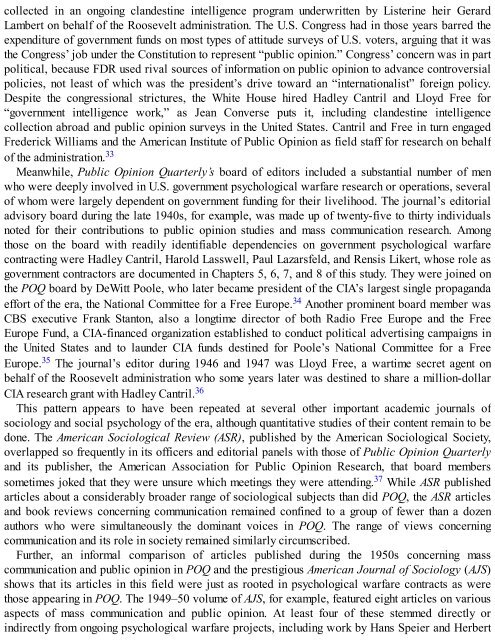9842659846
You also want an ePaper? Increase the reach of your titles
YUMPU automatically turns print PDFs into web optimized ePapers that Google loves.
collected in an ongoing clandestine intelligence program underwritten by Listerine heir Gerard<br />
Lambert on behalf of the Roosevelt administration. The U.S. Congress had in those years barred the<br />
expenditure of government funds on most types of attitude surveys of U.S. voters, arguing that it was<br />
the Congress’ job under the Constitution to represent “public opinion.” Congress’ concern was in part<br />
political, because FDR used rival sources of information on public opinion to advance controversial<br />
policies, not least of which was the president’s drive toward an “internationalist” foreign policy.<br />
Despite the congressional strictures, the White House hired Hadley Cantril and Lloyd Free for<br />
“government intelligence work,” as Jean Converse puts it, including clandestine intelligence<br />
collection abroad and public opinion surveys in the United States. Cantril and Free in turn engaged<br />
Frederick Williams and the American Institute of Public Opinion as field staff for research on behalf<br />
of the administration. 33<br />
Meanwhile, Public Opinion Quarterly’s board of editors included a substantial number of men<br />
who were deeply involved in U.S. government psychological warfare research or operations, several<br />
of whom were largely dependent on government funding for their livelihood. The journal’s editorial<br />
advisory board during the late 1940s, for example, was made up of twenty-five to thirty individuals<br />
noted for their contributions to public opinion studies and mass communication research. Among<br />
those on the board with readily identifiable dependencies on government psychological warfare<br />
contracting were Hadley Cantril, Harold Lasswell, Paul Lazarsfeld, and Rensis Likert, whose role as<br />
government contractors are documented in Chapters 5, 6, 7, and 8 of this study. They were joined on<br />
the POQ board by DeWitt Poole, who later became president of the CIA’s largest single propaganda<br />
effort of the era, the National Committee for a Free Europe. 34 Another prominent board member was<br />
CBS executive Frank Stanton, also a longtime director of both Radio Free Europe and the Free<br />
Europe Fund, a CIA-financed organization established to conduct political advertising campaigns in<br />
the United States and to launder CIA funds destined for Poole’s National Committee for a Free<br />
Europe. 35 The journal’s editor during 1946 and 1947 was Lloyd Free, a wartime secret agent on<br />
behalf of the Roosevelt administration who some years later was destined to share a million-dollar<br />
CIA research grant with Hadley Cantril. 36<br />
This pattern appears to have been repeated at several other important academic journals of<br />
sociology and social psychology of the era, although quantitative studies of their content remain to be<br />
done. The American Sociological Review (ASR), published by the American Sociological Society,<br />
overlapped so frequently in its officers and editorial panels with those of Public Opinion Quarterly<br />
and its publisher, the American Association for Public Opinion Research, that board members<br />
sometimes joked that they were unsure which meetings they were attending. 37 While ASR published<br />
articles about a considerably broader range of sociological subjects than did POQ, the ASR articles<br />
and book reviews concerning communication remained confined to a group of fewer than a dozen<br />
authors who were simultaneously the dominant voices in POQ. The range of views concerning<br />
communication and its role in society remained similarly circumscribed.<br />
Further, an informal comparison of articles published during the 1950s concerning mass<br />
communication and public opinion in POQ and the prestigious American Journal of Sociology (AJS)<br />
shows that its articles in this field were just as rooted in psychological warfare contracts as were<br />
those appearing in POQ. The 1949–50 volume of AJS, for example, featured eight articles on various<br />
aspects of mass communication and public opinion. At least four of these stemmed directly or<br />
indirectly from ongoing psychological warfare projects, including work by Hans Speier and Herbert









![Genki - An Integrated Course in Elementary Japanese II [Second Edition] (2011), WITH PDF BOOKMARKS!](https://img.yumpu.com/58322134/1/180x260/genki-an-integrated-course-in-elementary-japanese-ii-second-edition-2011-with-pdf-bookmarks.jpg?quality=85)
![Genki - An Integrated Course in Elementary Japanese I [Second Edition] (2011), WITH PDF BOOKMARKS!](https://img.yumpu.com/58322120/1/182x260/genki-an-integrated-course-in-elementary-japanese-i-second-edition-2011-with-pdf-bookmarks.jpg?quality=85)





